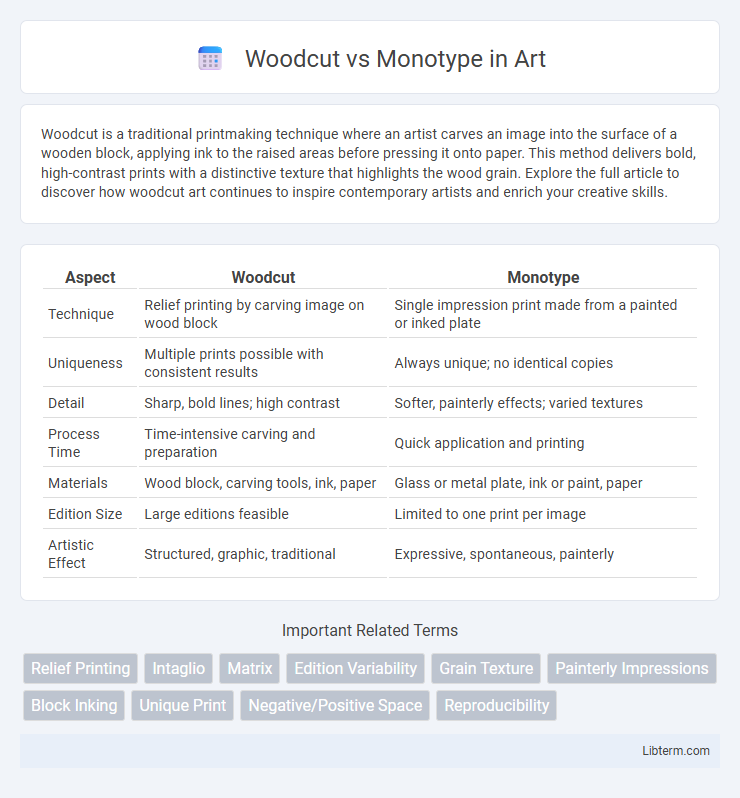Woodcut is a traditional printmaking technique where an artist carves an image into the surface of a wooden block, applying ink to the raised areas before pressing it onto paper. This method delivers bold, high-contrast prints with a distinctive texture that highlights the wood grain. Explore the full article to discover how woodcut art continues to inspire contemporary artists and enrich your creative skills.
Table of Comparison
| Aspect | Woodcut | Monotype |
|---|---|---|
| Technique | Relief printing by carving image on wood block | Single impression print made from a painted or inked plate |
| Uniqueness | Multiple prints possible with consistent results | Always unique; no identical copies |
| Detail | Sharp, bold lines; high contrast | Softer, painterly effects; varied textures |
| Process Time | Time-intensive carving and preparation | Quick application and printing |
| Materials | Wood block, carving tools, ink, paper | Glass or metal plate, ink or paint, paper |
| Edition Size | Large editions feasible | Limited to one print per image |
| Artistic Effect | Structured, graphic, traditional | Expressive, spontaneous, painterly |
Introduction to Woodcut and Monotype
Woodcut is a relief printing technique where an image is carved into a wooden block, leaving raised areas that hold ink for transfer to paper. Monotype, by contrast, involves painting or drawing directly onto a smooth surface like glass or metal, producing a single unique print when pressed onto paper. Both methods emphasize texture and bold contrasts but differ fundamentally in process and repeatability.
Historical Background of Printmaking Techniques
Woodcut, one of the oldest printmaking techniques dating back to East Asia around the 9th century, involves carving an image into a wooden block to create multiple prints. Monotype, developed in the 17th century by Italian artist Giovanni Benedetto Castiglione, produces unique prints by drawing or painting on a smooth surface before transferring the image to paper. Both techniques played crucial roles in the evolution of printmaking, with woodcut dominating early mass reproduction and monotype fostering experimentation in print uniqueness.
Overview of Woodcut Art
Woodcut art involves carving an image into the surface of a wooden block, with the raised areas representing the parts that will receive ink and create the print. This relief printing technique dates back to ancient times and remains one of the oldest methods of printmaking, known for its bold lines and high-contrast images. Woodcut prints typically feature strong textures and a distinctive graphic quality, making them popular among artists for their expressive potential.
Understanding Monotype Printmaking
Monotype printmaking produces a unique image by applying ink or paint directly onto a smooth surface such as glass or metal, which is then pressed onto paper, creating one-of-a-kind prints. Unlike woodcut, where a carved block can generate multiple identical prints, monotypes emphasize spontaneity and fluidity, allowing for expressive and dynamic results. This technique highlights the artist's immediate interaction with the medium, making each print a singular artistic expression rather than part of a reproducible edition.
Key Differences Between Woodcut and Monotype
Woodcut and monotype are distinct printmaking techniques with key differences in process and outcome. Woodcut involves carving an image into a wood block, where the raised surfaces hold ink for multiple prints, producing bold, textured lines. Monotype creates a unique image by painting or drawing on a smooth surface and transferring it to paper, resulting in one-of-a-kind prints with softer, more fluid effects.
Materials and Tools Needed
Woodcut printing requires a block of hardwood, such as cherry or basswood, which is carved with gouges and knives to create a relief design. Ink is applied with a brayer or roller onto the raised surface, and paper is pressed onto the block either by hand or with a press. Monotype printing utilizes a smooth metal or plexiglass plate, where ink or paint is applied directly with brushes, rollers, or spatulas; the image is then transferred to paper through manual pressure or a printing press, with no reusable matrix.
Artistic Processes: Step-by-Step Comparison
Woodcut involves carving designs into a wooden block, removing non-image areas so the raised surface prints inked patterns; the artist must carefully plan negative space and apply ink evenly before pressing paper onto the block. Monotype creates a singular print by painting or drawing directly onto a smooth surface, such as glass or metal, and then transferring the image to paper with pressure, resulting in unique impressions that cannot be replicated exactly. The woodcut process emphasizes precision and repetition, while monotype prioritizes spontaneity and one-of-a-kind expressive marks.
Visual Effects and Aesthetic Qualities
Woodcut prints showcase bold, high-contrast lines and textures due to the carving process on the woodblock, resulting in a graphic and often dramatic aesthetic. Monotypes offer unique visual effects with their smooth gradients, painterly textures, and the unpredictability of ink transfer, creating softer and more atmospheric images. The tactile qualities of wood grain in woodcuts contrast with the fluid, spontaneous marks achievable in monotype prints, highlighting the distinct artistic expressions of each technique.
Popular Artists and Iconic Works
Albrecht Durer is a renowned woodcut artist whose detailed prints like "The Four Horsemen of the Apocalypse" exemplify the precision of woodcut techniques. In contrast, monotype artists such as Edgar Degas created unique works like "Woman at Her Toilette" that showcase the spontaneity and fluidity possible in monotype printing. Both mediums highlight influential contributions to printmaking, with woodcuts emphasizing sharp lines and repetition, and monotypes prized for their singular, painterly qualities.
Choosing the Right Technique for Your Art
Woodcut offers sharp, bold lines and strong contrasts ideal for detailed, graphic designs, while monotype provides unique, painterly effects with rich textures through single impressions. Choosing the right technique depends on the desired visual impact, whether precise, repeatable patterns or spontaneous, one-of-a-kind prints. Artists should consider their style, project goals, and material preferences to select the optimal method for creative expression.
Woodcut Infographic

 libterm.com
libterm.com